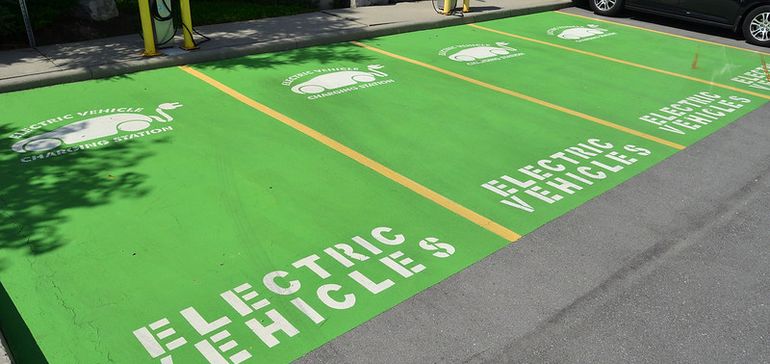|
Getting your Trinity Audio player ready...
|
As the time approaches when states begin doling out electric vehicle (EV) charging funds from the National Electric Vehicle Infrastructure (NEVI) program, some c-stores could get up to 80% of certain EV charging costs reimbursed.
It’s a lot of money to help offset what can be a very expensive installation. And retailers can help make the process as smooth as possible by ensuring that they meet federal requirements, then determining their strategy for EV installation ahead of the state funding applications opening.
The NEVI program was set down by the Joe Biden Administration last year as a way to support the installation of 500,000 electric charging stations across the U.S. The program includes $7.5 billion for building out a refueling framework for vehicles running on alternative fuels, such as EVs or those using natural gas, hydrogen or propane. That $7.5 billion includes $5 billion over five years split among the states plus the District of Columbia and Puerto Rico, then an additional $2.5 billion discretionary pool with different requirements that’s not earmarked for specific states.
The Biden Administration approved funding for all 50 states along with Washington, D.C., and Puerto Rico in September, and now those states are getting ready to open up applications for businesses looking to obtain funding through the program. Some states, like California, have established rough deadlines for c-stores and other companies to apply for funding, while others have yet to do so.
“The NEVI program is attempting to develop this [direct current] fast-charging network, what I think of as a critical backbone of DC fast charging across some of the biggest, most trafficked … roadways across the country,” said Ben Shapiro, manager of the Rocky Mountain Institute’s (RMI) Carbon-Free Mobility team, in an interview. RMI, a clean energy nonprofit, recently helped Oregon’s Department of Transportation as it developed its NEVI plan.
Shapiro said that while a significant amount of electric charging will occur at consumers’ homes, it isn’t feasible for everyone right now and won’t be sufficient for all needs. That’s why the NEVI funding was created — to build a network of direct current fast charging (DCFC) stations at publicly available locations like c-stores and shopping centers near major thoroughfares.
As states move toward opening applications, interested retailers should gather information and prepare to apply.
Federal guidelines form the backbone of NEVI funding
Potential applicants first must ensure that they meet the federal guidelines.
The Federal Highway Administration’s fact sheets say funds can be used for the purchase and installation or upgrade of EV charging stations. But the money can also be used for planning and development purposes like environmental review or design work, signage for EV charging locations, outreach to disadvantaged communities, data sharing and more.
Potential EV charging locations should also be able to operate reliably even in extreme temperatures and maintain a reasonable cost to consumers while not putting too much of a burden on the power grid.
And not every location will be eligible for NEVI funding.
“For example, the charging station must be available 24 hours a day, which is a good baseline requirement,” said Quincy Lee, founder and CEO of Electric Era, a manufacturer of AI driven battery-assisted EV chargers, in an interview. “It must be publicly available too. It can’t be in a parking garage hidden away.”
That doesn’t mean a c-store has to be open 24 hours a day — just that the charging hardware should work even if the store is closed.
The bulk of the money is earmarked for locations along alternative fuel corridors — routes where drivers using alternative fuels can count on regular opportunities to recharge or refill. States have been submitting applications to the Federal Highway Administration since 2016 to get vital stretches of their roads designated as alternative fuel corridors.
“Think interstates and state highways,” said Lee.
Eligible locations along these routes should be no more than 1 mile from the highway. There’s also a focus on sites with multiple amenities around, including restaurants and travel centers or convenience stores — making the latter a natural fit.
In addition to being near the alternative fuel corridors, sites need to be reasonably spaced along the routes.
”They need to basically be spread 50 miles apart,” said Lee. “You can’t have a large clustering of NEVI-funded EV fast charging stations … all within one city block, they need to be spread apart by 50 miles along the highway corridor.”
Experts said this means competition may be higher for these funds in dense urban areas.
The local connection
The second step for eligible locations is to actually apply for the NEVI funds.
Each state will determine its own process for distributing funds, and states will announce those application processes as they become finalized.
”Every state is going to look different,” Lee said. “Some states are going to have an application process, some states are going to have a rebate program, some states are going to have a combination of the two.”
California, which has the second-most c-stores in the U.S., held two meetings on NEVI funding and posted the videos online for interested parties to view. The California Transportation Department and the California Energy Commission gave a rough timeline for their applications.
Brian Fauble, an energy commission specialist for the California Energy Commission, said the state would open applications sometime in the first quarter of 2023, and close them again roughly three months later during the first presentation in September. Approved projects would begin near the end of 2023. There would then be new solicitations for bids about every six months, with each targeting a different group of the state’s alternative fuel corridors.
Texas, which last year contained over 10% of all U.S. convenience stores, has guidelines available online for c-store operators and others interested in pursuing NEVI funding. The Texas Department of Transportation includes a list of preparations site owners can make ahead of time.
That list includes getting an electrical site assessment and understanding what upgrades a location may need to accommodate fast chargers.
“Reach out to the local electric utility,” Shapiro suggested. “They might have some programs that provide meaningful funding, or programs where they have dedicated staff that can … walk through a lot of this.”

Getting started early is important, Shapiro noted, because getting an EV charger hooked up may take longer than site owners expect.
“It can take meaningful investment of both time and resources on the part of the utility to bring the requisite amount of electric power to that site,” he said.
Retailers should also research permitting and inspecting requirements in their market areas.
“Some states and some localities provide streamlined permitting for EV charging as kind of a recognition that this is something we need developed quickly,” Shapiro said. “But it’s another part of the diligence, the research to do up front to understand, ‘what does it look like in my area to get this done?’”
The Texas DOT highlighted researching EV charging vendors ahead of time, so applicants will be able to answer questions about things like how customers will pay and how reliable the hardware is.
The Fuels Institute also released a report last year that goes more into detail about aspects like location, technological requirements and tips like making sure Wi-Fi is available in areas where cell phone connections may be weak.
NEVI funding could provide a significant boost for the right stores in the right locations, but interested companies will have to carefully think through their goals for funding and then devote plenty of time to the application process.
“I think that there’s not a whole lot of doubt this transition is coming,” Shapiro said. “You see it on the policy side, you’ve seen it on the automaker side, you see it on the consumer demand side. And so if you’re a convenience store owner, you want to be relevant for consumers that are increasingly to be driving a different type of vehicle.”



